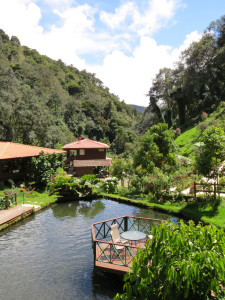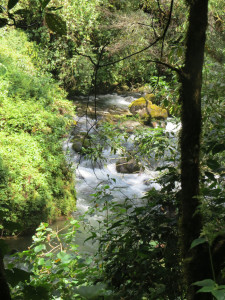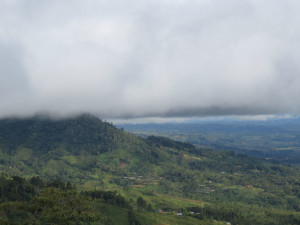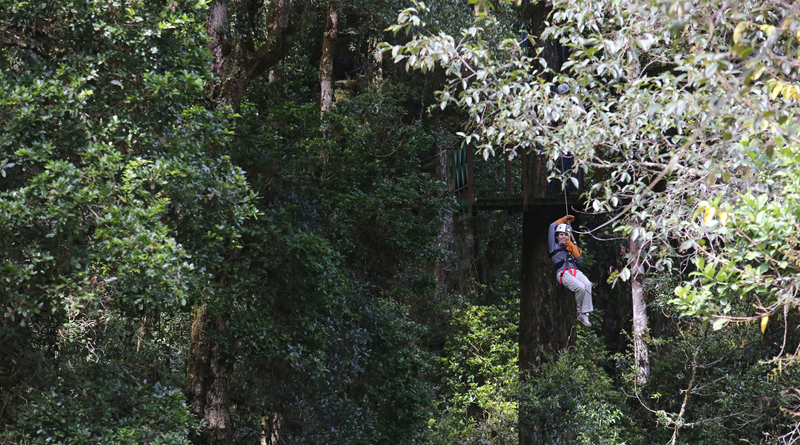THE CLOUD FORESTS OF COSTA RICA
Most people think of Costa Rica as hot, hot, hot. And most of the time it is. But if you travel to the highland cloud forests of San Gerado de Dota, be prepared to get cold.

Although you are technically in a valley the elevation is still over 2400m so at night the temperature drops dramatically. Fortunately, at Trogon Lodge where I was lucky enough to stay, they pop a hot water bottle into your bed so by the time you retire it’s toasty warm between the sheets.
The lodge has its own trails; an easy 1km or a slightly tougher 3km circular route will take you into the forest following the river past waterfalls and over little bridges.
The trees are tall and covered in mosses and lichens and bright red bromeliads. Below you will see fungi in varying shades from dark red to pitch black to sulphurous yellow. Hummingbirds dart between the flowers and black vultures circle overhead – only just visible through the thick tree-top canopy.
Early morning is always a good time to spot wildlife – and the jewel in the birding crown is a sighting of the appropriately named, resplendent quetzal. A bird that is so beautiful it pretty much, single handedly, started bird watching tourism in Costa Rica.
But quetzals aren’t the only birds; yellow thighed finches (a truly comical looking bird), flycatchers, tanagers and swifts all flit around the gardens.
The area was once home to a tiny shrimp that lived in the cold streams that race down the mountain side, but after trout were introduced these shrimps were eaten to local extinction. Without the shrimp the trout still survived but no longer achieved the giant sizes that attracted anglers from afar. Reminders of this short lived trout heyday can be seen in the number of small trout farms run by local families.

A great way to explore the area is on horseback. Horses were once an essential part of the Costa Rican economy and agricultural infrastructure, and although they have now been replaced by motorised vehicles they still hold an important place in the culture. A gentle ride followed by an easy hike will take you to a pretty waterfall. It’s a roaring mass of white foam accessed via a rickety looking metal walkway – health and safety in the UK would have a field day! But don’t let that put you off – it’s worth the climb down and if you don’t mind small spaces, squeeze under the low hanging rocks to view the waterfall from the other side.
Once it gets dark, the rain has usually passed and there is an opportunity to take a short night hike along the trails looking for nocturnal wildlife. Orange nectar bats, large moths, fungus that fluoresces in the dark, and the rustle of late night mammals all add to the experience. If you are lucky you may spot an owl, or perhaps even a racoon – but as my guide, Henry, said to me as I returned to the lodge – even if you didn’t see them, you can be sure they saw you!
If visiting in the wet season (May to November) – expect rain. But, unlike the UK, the rain here is so predictable that you can almost set your watch by it. So it’s easy to plan your activities around the day’s cloud burst. It usually arrives in the afternoon and hangs around for a couple of hours. The big advantage of visiting at this time of year is that it’s low season – with far fewer foreign tourists joining you in gawping at Costa Rica’s wonders.

The cloud forests live up to their name – they spend much of their time shrouded in swirling white mists that creep across the tree-tops giving the branches an eerie ghost-like appearance. However the mornings are often cloud-free, as sunlight burns through the mists of the day before and heats the air, before the afternoon clouds and rains reassert themselves.
San Gerado de Dota is only a couple of hours from San Jose so it is easy to include in your Costa Rican itinerary. Just remember that strong shoes, a warm jumper, sunscreen, camera and binoculars are a must when visiting this area.
FACT BOX:
Visiting Costa Rica: www.visitcostarica.com
About the Author:
Chantal Cooke is an award winning journalist and broadcaster with a passion for the planet. In 2002 she co-founded the award winning radio station PASSION for the PLANET and in 2009 Chantal was awarded London Leader in Sustainability status. Chantal also runs a successful communications agency – Panpathic Communications.


